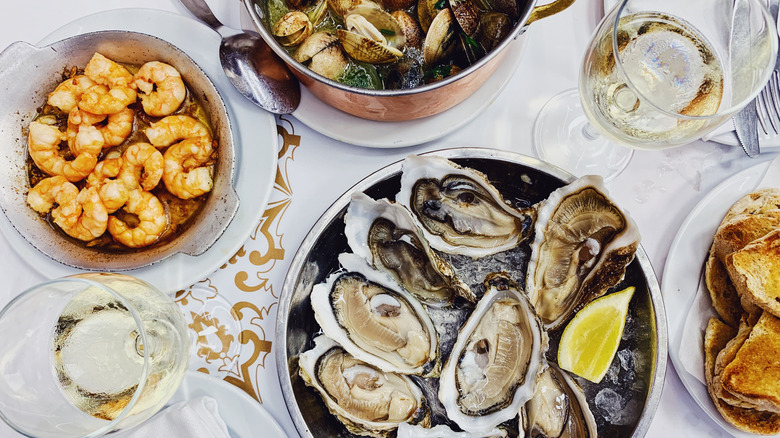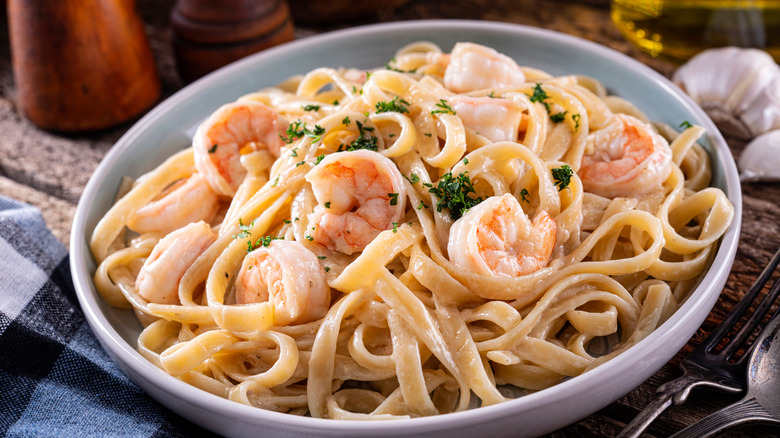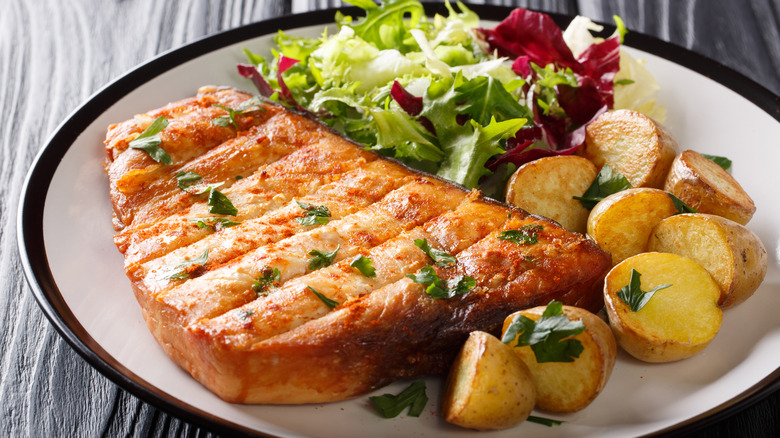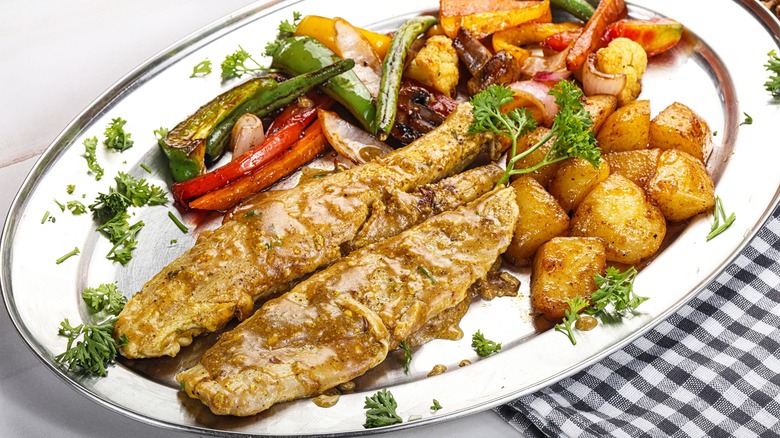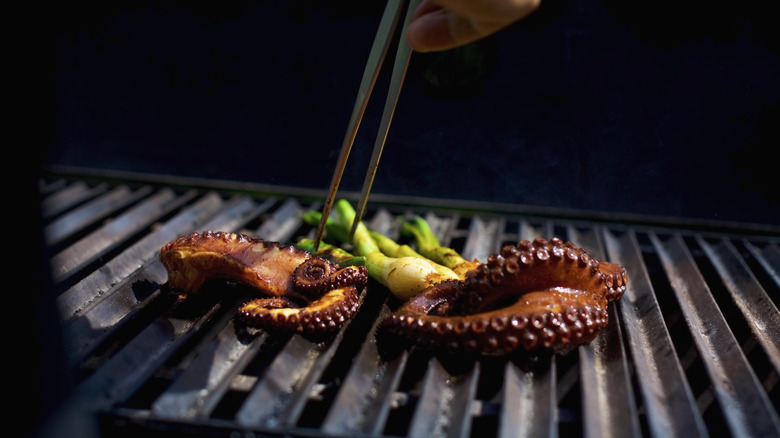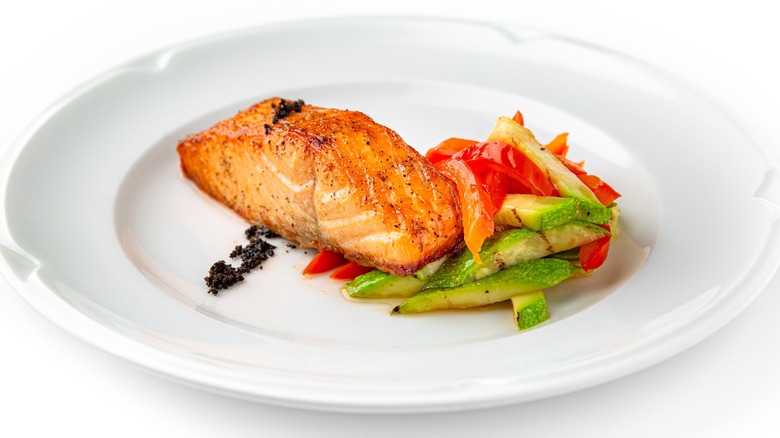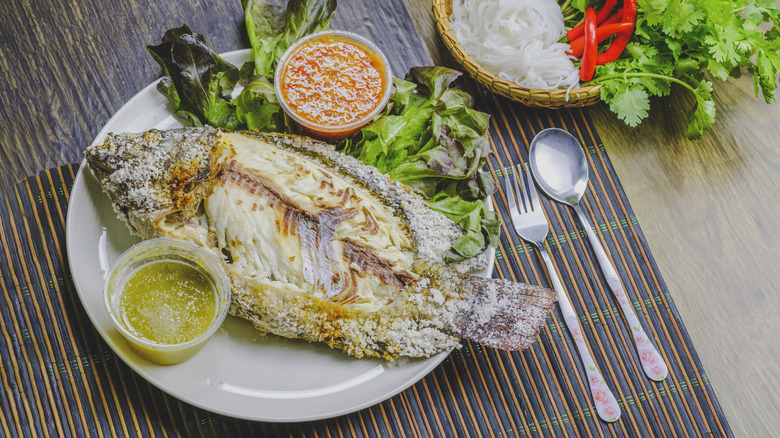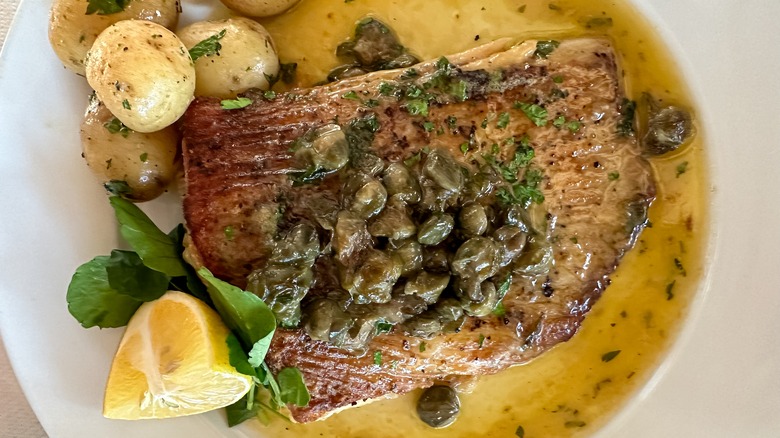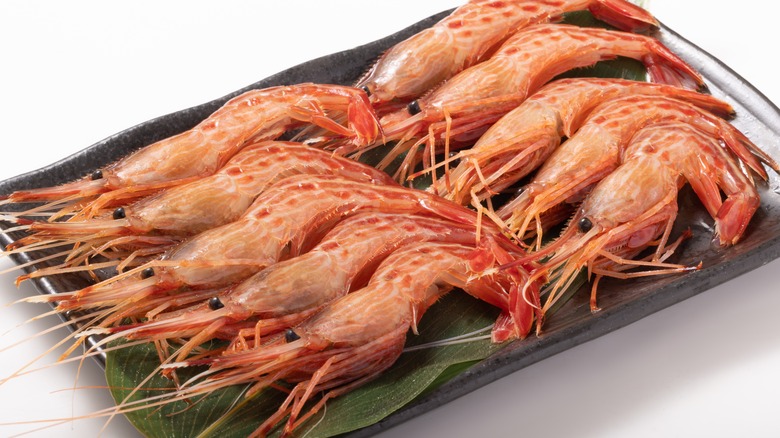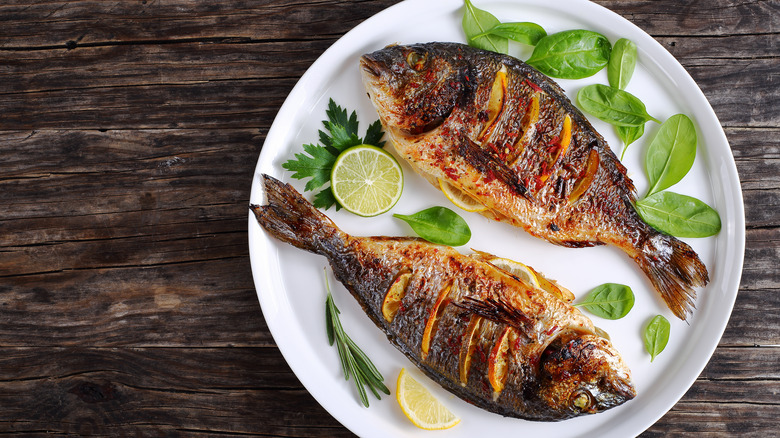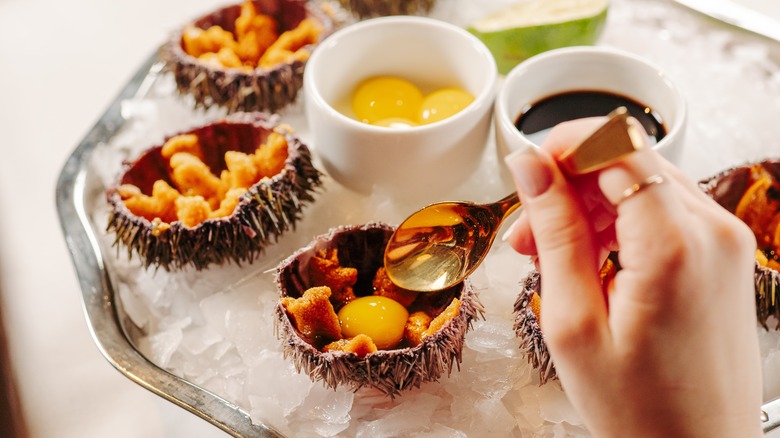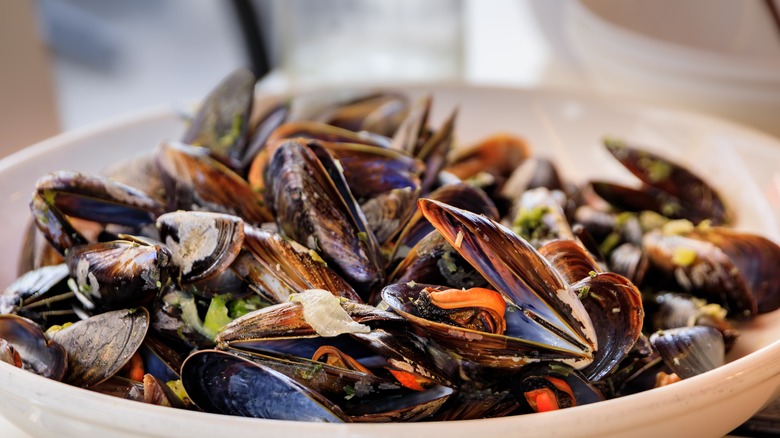11 Seafood Dishes Chefs Will Never Order
Seafood can be a bit of a mixed bag. When it's good, it's heavenly, but when it's bad, it can range from off-putting to downright dangerous — which is why professional chefs are careful what they order when eating seafood in a restaurant. For chef Tony Inn, Executive Chef of Kin Gin, the first order of business is to choose a restaurant specializing in seafood — and not just because you know there's an expert behind the range. "Venues that sell a lot of particular item tend to have a higher turnover, meaning the ingredients are fresher and quality tends to be better," he says.
It's also a good idea to remember where in the world you are, explains chef Michael Correll, Executive Chef of Ruse. "I'm not going to going to a diner in Nebraska and ordering the crab cake," he says. "I'm not saying you can't get good seafood in middle America but it does have its limitations."
Above all, don't be afraid to ask questions, specifically regarding provenance, suggests chef Oscar Cabezas, Executive Chef of Teleferic Barcelona. "I usually go to restaurants that have direct contact with their sources and I ask what the catch of the day is." By and large, our experts recommend being adventurous. "Don't always go for the most familiar item," suggests Stephanie Sandfrey, Executive Sous Chef, Jaleo Las Vegas. That said, there are a few seafood dishes our experts generally eschew. Here are the ones even the pros won't order.
1. Shrimp fettuccine alfredo
Pairing fish and cheese has long been a point of contention, something that may date back to ancient times. Aristotle warned that cheese, which he claimed takes a long time to digest, and fish, which rots quickly, could interact with one another during digestion in bad ways. The cheese could cause the fish to go rotten and force it into the liver, Aristotle claimed. While the success of everything from tuna melts to Greek shrimp saganaki show that eschewing the combo is likely unnecessary, many chefs continue to avoid it.
"Growing up in south Italy, fish and cheese are always served separately," says Executive Chef Davide D'Andrea of Rosebud Restaurants, noting that cheese could overpower delicate fish. Cabezas, a native of Barcelona, agrees and notes that his "gastronomic tradition does not mix cheese with seafood." It's for this reason that chefs may pooh-pooh some plays on Italian classics, including the cheese-laden shrimp fettuccine alfredo.
But some are a bit more flexible in their approach, like Inn. "I personally don't have an issue with it," he says. "I grew up in a predominantly 'American Italian' neighborhood and honestly, we ate that quite a bit growing up." Josh Copeland, Owner of Camino Alto in San Francisco, adds that while he learned not to pair seafood and cheese many years ago, these days, he's a bit more relaxed around it: "Given the liberties chefs make today, it would be odd to make that combo one's line in the sand."
2. Swordfish
Swordfish, when prepared properly, is a real treat that is both meaty and rich. But for many experts, including Sandfrey, it's not worth ordering in restaurants due to its potentially high mercury content. Like other large, carnivorous fish, swordfish boasts fairly high levels of the heavy metal. In fact, at a mean concentration of 0.995 parts per million, per the FDA, (as compared to 0.979 ppm for shark, 0.73 ppm for king mackerel, or 0.689 ppm for bigeye tuna), swordfish has one of the highest mercury loads out there.
Mercury is toxic for humans. When it accumulates in the body over time, it can lead to major health concerns, including an increased risk of cardiovascular disease, according to a 2002 paper published in The New England Journal of Medicine. Even low levels of mercury can be toxic, according to a 2005 study in Environmental Toxicology and Pharmacology.
But that's not the only reasons our experts avoid ordering swordfish in restaurants. "Swordfish is a 'no thank you' for me," says Copeland. "Without getting too graphic, once the executive chef at Square One (almost 30 years ago) showed me why he won't eat them, I've never ordered one." We asked him to humor us and be a bit more graphic, and he obliged, citing a greater occurrence of both parasites and tumors as compared to other fish. "Then I learned about mercury levels and their endangered status," he says. "For all those reasons my preference is to avoid them."
3. Shark
Shark has one of the highest mercury loads of any fish, with a concentration mean of 0.979 ppm, according to the FDA. But this isn't why D'Andrea avoids ordering shark in restaurants, citing instead the sustainability issues that plague this ocean predator. While some shark fisheries in the U.S. have been deemed sustainable by the Marine Stewardship Council — including the spiny dogfish fishery, the largest in the U.S., — these slow-growing carnivores remain vulnerable, due to a variety of factors that include habitat loss, climate change, and unfair public perception. The impact of shark finning also plays a role in the demise of sharks, as they are targeted in the production of delicacies like shark fin soup.
"There are a ton of fish I avoid given their lack of sustainability," says chef Andrew Zimmern, whose 2024 PBS series Hope in the Water (on which Zimmern serves as a producer) delves into the issue at length. "If it's not from a sustainable fishery, I don't eat it. If something is not regenerative from the ocean, I do not eat it, full stop."
Fishery sustainability is constantly evolving and changing, however. Mackerel was a poster child of sustainability until recently, when the Marine Conservation Society reported that increased demand had led them to shift it from a green rating to amber. Bluefin tuna, meanwhile, "used to be the most controversial one," says Correll, "but as of recently it's made a comeback especially with the tuna farms popping up in Spain and Mexico."
4. Octopus
The 2020 Netflix documentary "My Octopus Teacher" highlighted the intelligence and emotional depth of which octopuses are capable, and so many stopped eating octopus altogether. That included business magnate Richard Branson, who told The Independent, "I can assure you that I've not eaten octopus since [watching the film], and can't see how anybody could ever eat octopus again after seeing it." Copeland was one former octopus-eater who gave it up after watching the documentary. "Sometimes a piece of art moves one to change the way they see the world," he says. "That movie, whether 100% accurate or not, did that for me."
Octopuses are indeed incredibly intelligent and some species have been observed solving mazes, getting in and out of containers, and even displaying mischievous behaviors. But despite highlighting their intelligence, the documentary didn't have the same effect on everyone. "I still eat octopus," says Zimmern. "I loved the documentary, but I think octopus is still delicious to eat, and I eat it." D'Andrea, too, enjoys dining octopus, whether it's raw or grilled. "I personally haven't seen the show," he says, "so I can't comment on the way people feel about eating the fish." Some even continue to eat still-wriggling tentacles known as potentially dangerous sannakji.
Inn, meanwhile, loves to order octopus in restaurants precisely because of how much he dislikes preparing it. "I hate cooking it, but I love eating it," he says, "especially when it's done right: tender on the inside and crispy charred on the surface."
5. Cheap salmon
Salmon is one of the more expensive fish out there, especially if you opt for top varieties like seriously pricey king salmon. But some restaurant menus feature salmon at stunningly low prices — and for our experts, this deal just isn't worth it. "If you buy salmon at a fast-casual (or just fast) restaurant," says Copeland, "it's likely going to be Atlantic salmon, which is probably the lowest farming standard of all salmon."
Salmon farming began in earnest in the 1960s and the industry swiftly became rife with controversy. These days, about 70% of the world's salmon is farmed. But salmon farms have historically been linked with poor stewardship practices, according to Sandfrey, like overcrowding or overuse of antibiotics. These practices, she says, "result in poor quality fish, and you can see it in the product as it arrives."
Thankfully, standards in the salmon farming industry have much improved of late, with industry-wide efforts that include moving salmon farms away from wild salmon migration routes and reducing an over-reliance on chemicals to combat disease and parasites. These efforts, particularly open water farming, according to Sandfrey, generally lead to a better-quality product.
But for D'Andrea, there's no contest: "Wild always tastes better," he says. And wild-caught salmon will practically always be more expensive, often to the tune of three to four times the price of farmed salmon. "If the price seems too good to be true," says Copeland, "it is."
6. Tilapia
If you ever find "wild-caught tilapia" at a market, the reality is that your leg is probably being pulled. A freshwater fish native to Africa, tilapia is particularly well-suited to farming. It doesn't mind being overcrowded in small spaces and it grows particularly quickly, making it cheap to get to market size. It's no surprise that it's almost exclusively produced on farms around the world.
But the low-maintenance tilapia fishery is rife with problems that may have you rethinking buying this fish again, including pollution with chemicals or even animal feces, particularly on some of the Chinese farms that provide the U.S. with the majority of its tilapia. As a result of these prevalent issues, D'Andrea avoids ordering tilapia in restaurants.
He even notes that despite the fish having a famously mild flavor, he has developed a distaste for it after learning how it's produced. "Since the farms grow all the fish in the same vicinity, the fish aren't able to be raised in a clean environment," he says. "Knowing this information leaves me uneasy and is why I personally won't ever order this fish to eat."
7. Pan-seared skate
Sometimes, an individual memory can change one's desire to eat a given food forever. This is the case of Inn's experience with pan-seared skate, which he says he can't eat given the "childhood trauma of seeing it at live markets." Growing up in Taiwan, he recalls, "my grandmother and I always went to live markets for fresher produce, higher quality of proteins, and better prices." He can see, as an adult, why this was her preferred method of shopping for fresh fish and seafood, but the seafood section of the market, he says, "was intense for a kid."
"Most of the creatures were alive in tanks, swimming until you picked them," he says. "The vendor would then grab your choice and chop it up right there. The left-over pieces went on a bed of ice pulsing for air and waiting for the next customer." The freshness, he says, was all but impossible to deny, but the smell of skate specifically "still haunts me."
8. Local, seasonal specialties
Some chefs eschew certain fish and seafood in restaurants, not because they dislike them, but because they are at their best when eaten in their place of origin. Such is the case of lobster, Zimmern says, which he refuses to order "unless I'm at a lobster shack in Maine." He applies much the same rule to "certain types of whelks and big sea snails," which he refuses to order given how long they typically have to travel to get to him. "I'm not gonna order them after they've made a 3,000 mile trek over here," he says. "Because they've just made too far a schlep. But I love eating them in their countries of origin."
Inn feels the same way about hokke, also known as okhotsk atka mackerel (which is predominantly caught around Japan's northern Shiretoko Peninsula)or sanma, a.k.a. Pacific saury, a fish whose seasonal migrations makes it particularly synonymous with autumn in Japan. "The quality is just not up to par," Inn says of these fish, "due to seasonality and low demands here in the U.S."
Certain recipes, too, seem particularly suited to places where they are most popular. Zimmern cites Belgian mussel stew billi bi, and Correll the grilled red carabinero he had at Bar Ganbara in San Sebastián. For Correll, it was "life changing," and as a result, he avoids it elsewhere. "[I] will probably never eat a piece of seafood as delicious as that," he says. "I have to go back!"
9. Whole grilled fish
Whole grilled fish may seem like the best, perhaps even the most natural way of consuming seafood. This technique is widely thought to showcase the base ingredient in its entirety and so gives you little chance of having the wool pulled over your eyes. But Cabezas never orders whole grilled fish — at least, not in the U.S. — due to the way most American chefs approach cooking it. "I think there is a culture in America of eating fish well done," he says. "This is why I usually avoid ordering whole pieces, especially grilled, within the United States." He saves this order for when he's in northern Spain, especially Catalonia and the Basque region. Here, he says, the preferred cooking temperature is closer to his own preference of medium rare.
Sandfrey also avoids ordering whole fish in the U.S. "Not for any particular reason," she says, "but I imagine if I went abroad, and I were near the ocean and I could have grilled whole fish straight from the water, I would do that."
10. Sea urchin
Sea urchin was long a mainstay of sushi restaurants almost exclusively, but these days, its presence is a rising trend on all sorts of menus. That's surely a boon for the urchin population explosion that has recently taken root in California, following the decline of the creature's more natural predators in the area, such as sea otters. But D'Andrea nevertheless avoids ordering sea urchin on American restaurant menus, citing an all-too-common lack of transparency regarding its provenance. "I personally would never order that off a menu in the States," he says, "because you don't know where it's coming from and the quality of the fish."
Like some other seafoods, sea urchin can indeed be contaminated with bacteria, parasites, or even viruses like norovirus, according to one 2020 report published in Food Control. And because urchins are typically eaten raw, that threat of contamination can be all the more concerning.
Of course, if you trust the restaurateur, this is less likely to be a problem. "You earn trust by maintaining good practices on an ever-changing menu," says Copeland. "If a restaurant has earned my trust, I'm all in, baby."
11. Mussels
The late, great Anthony Bourdain was perhaps the first celeb chef to publicly eschew eating mussels in restaurants, but he was far from the last. "I'm glad to agree with Toni!" says Cabezas. "I usually don't order mussels. They are poorly cleaned and it is a mollusk that is usually quite contaminated." Sandfrey agrees, noting that she has always found mussels are a bit suspect. "They are a low cost item almost always with an exorbitant cost," she says.
But not all of our chefs agree, including Zimmern, who notes that while Bourdain passed on mussels in other restaurants, "he served them at Les Halles!" On the contrary, Zimmern says, mussels are his "barometer dish," the item he orders to see if a restaurant is doing things properly. "Because they're so fragile, and because they can be so bad, I can tell whether or not a restaurant knows what they're doing by ordering the mussels," he says. "Mussels should be big and heavy and plump, and the meats should fill the shell, and if you're not getting that, then the restaurant's not doing their job."
Indeed, when they're well-sourced and well-prepared, D'Andrea says, fresh mussels "can be exquisite." The secret here is ensuring that you're only getting the best. "I always first ask where the mussels come from," he says. "I personally love the ones from the Mediterranean Sea. They have so much flavor. I love it paired with pasta or served with garlic, lemon, and olive oil."
